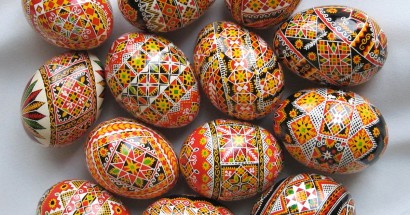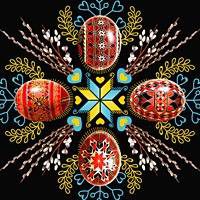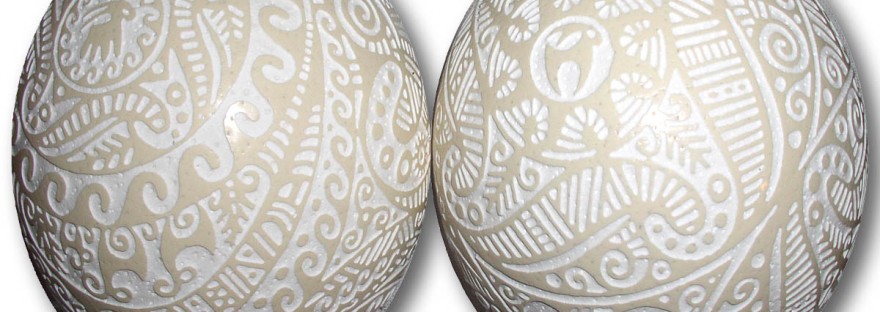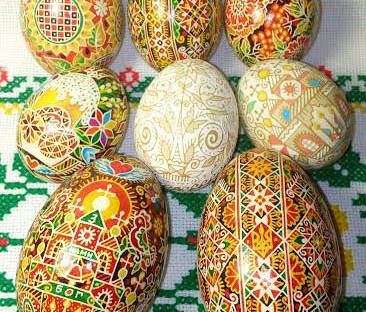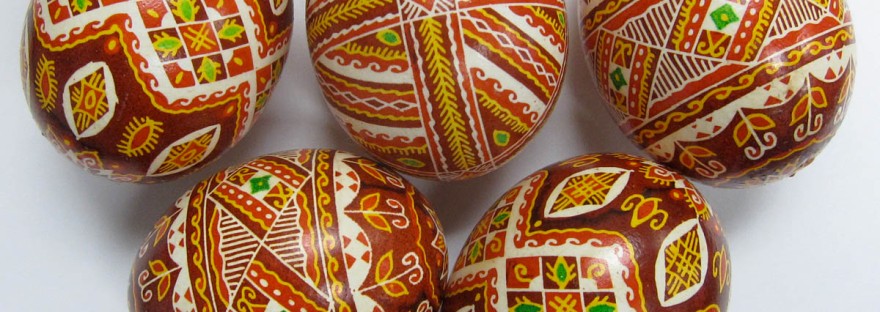There is a wide variety of decorative motifs used on pysanky. In pre-Christian times these symbols infused an egg with magic to ward off evil, banish winter, bring about a good harvest as well as luck. After 988, when Christianity became the state religion of Ukraine, the interpretation of many of the symbols began to change, and the pagan motifs were reinterpreted in a Christian light.
Since the mid-19th century, pysanky have been created more for decorative and traditional purposes rather than due to a belief of magic. Furthermore, the Ukrainian diaspora has reinterpreted meanings and created their own new symbols.
The names and meaning of various symbols and design elements vary from region to region, and even from village to village. Similar symbols can have totally different meaning in different places. *Note that these meanings applied to traditional folk pysanky with designs, not to modern original creations.
Geometric
“The most popular pysanka designs are geometric figures. The egg itself is most often divided by straight lines into squares, triangles and other shapes. These are also among the most ancient symbols, with the решето (resheto, sieve) motif dating back to Paleolithic times. Other ancient geometric symbols are agricultural in nature: triangles, which symbolized clouds or rain; quadrilaterals, especially those with a resheto design in them, symbolized a ploughed field; dots stood for seeds.
The triangle is said to symbolize the Holy Trinity. In ancient times it symbolized other trinities: the elements of air, fire and water, the family (man, woman and child) or the cycle of life (birth, life, and death). Diamonds, a type of quadrilateral, are sometimes said to symbolize knowledge. Curls/spirals are ancient symbols of the Zmiya/Serpent, and are said to have a meaning of defense or protection. The spiral is said to be protective against the “нечиста сила”; an evil spirit which happens to enter a house will be drawn into the spiral and trapped there. Dots, which can represent seeds, stars or cuckoo birds’ eggs (a symbol of spring), are popularly said to be the tears of the blessed Virgin. Hearts are also sometimes seen, and, as in other cultures, they represent love.
Eternity bands
Eternity bands or meanders are composed of waves, lines or ribbons; such a line is called a “bezkonechnyk.” A line without end is said to represent immortality. Waves, however, are a water symbol, and thus a symbol of the Zmiya/Serpent, the ancient water god. Waves are therefore considered an agricultural symbol, because it is rain that ensures good crops.
Berehynia
The goddess motif is an ancient one, and most commonly found in pysanky from Polissia or Western Podillia. The berehynia was believed to be the source of life and death. On the one hand, she is a life giving mother, the creator of heaven and all living things, and the mistress of heavenly water (rain), upon which the world relies for fertility and fruitfulness. On the other hand, she was the merciless controller of destinies.
The goddess is sometimes depicted with arms upraised, and the arms vary in number but are always in pairs: 2, 4 or 6. This is similar to the appearance of the Christian Oranta. Pysanky with this motif were called “bohyn’ky” (богиньки, little goddesses) or “zhuchky” (жучки, beetles), the latter because they are similar in appearance to the Cyrillic letter Ж (zh). Sometimes the berehynia has become abstracted, and is represented by a plant—vazon—the tree of life. Her arms become the branches and flowers, and she is firmly rooted in a flowerpot.
Christian symbols
The only true traditional Christian symbol, and not one adapted from an earlier pagan one, is the church. Stylized churches are often found on pysanky from western Ukraine, particularly those in the Hutsul regions and Bukovyna; a sieve motif inside is said to symbolize the church’s ability to separate good from evil.
Crosses are fairly common, although most of those found on traditional pysanky are not Ukrainian (Byzantine) crosses. The crosses most commonly depicted are of the simple “Greek” cross type, with arms of equal lengths. This type of cross predates Christianity, and is a sun symbol (an abstracted representation of the solar bird); it is sometimes combined with the star (ruzha) motif.
Other adapted religious symbols include a triangle with a circle in the center, denoting the eye of God, and one known as the “hand of god.” Nowadays, pysanky are being written with depictions of Easter baskets on them, including a paska and candle. White doves, symbols of the Holy Spirit, are more frequently seen.
Phytomorphic (Plant) motifs
The most common motifs found on pysanky are those associated with plants and their parts (flowers and fruit). Women who wrote pysanky drew their inspiration from the world of nature, depicting flowers, trees, fruits, leaves and whole plants in a highly stylized (not realistic) fashion. Such ornaments symbolized the rebirth of nature after winter, and pysanky were written with plant motifs to guarantee a good harvest. A most popular floral design is a plant in a vase of standing on its own, which symbolized the tree of life and was a highly abstracted version of the berehynia (great goddess).
Pussy willow branches are sometimes depicted on pysanky; in Ukraine, the pussy willow replaces the palm leaf on Palm Sunday. This is not a common motif, though, and may be a more recent addition.
Two very popular plant motifs on modern diasporan pysanky are poppies and wheat; these motifs are never seen on traditional pysanky, and are purely a modern invention.
Vazon/Tree of Life
The “tree of life” motif is widely used in traditional pysanky designs. It can be represented in many ways. Sometimes it appears as two deer on either side of a pine tree. More often it manifests as a flower pot (“vazon”), filled with leaves and flowers. The pot itself is usually a rectangle, triangle or a rhomboid (symbolic of the earth), and is covered with dots (seeds) and dashes (water). Many branches grow out of it, in a symmetric fashion, with leaves and flowers. This plant is a berehynia (goddess) symbol, with the branches representing the many arms of the mother goddess.
Fruit
Fruit is not a common motif on pysanky, but is sometimes represented. Apples, plums and cherries are depicted on traditional pysanky. Currants and viburnum (kalyna) berries are sometimes seen, too. These motifs are probably related to fecundity. Grapes are seen more often, as they have been transformed from an agricultural motif to a religious one, representing the Holy Communion.
Zoomorphic (Animal) motifs
Although animal motifs are not as popular as plant motifs, they are nevertheless found on pysanky, especially those of the people of the Carpathian Mountains. Animal depicted on pysanky include both wild animals (deer, birds, fish) and domesticated ones (rams, horses, poultry). As with plants, animals were depicted in the abstract, highly stylized, and not with realistic detail.
Horses were popular ornaments because they symbolized strength and endurance, as well as wealth and prosperity. They also had a second meaning as a sun symbol: in some versions of pagan mythology, the sun was drawn across the sky by the steeds of Dazhboh, the sun god. Similarly, deer designs were very prevalent as they were intended to bring prosperity and long life; in other versions of the myth, it was the stag who carried the sun across the sky on his antlers. Rams are symbols of leadership, strength, dignity, and perseverance.
Birds
Birds were considered the harbingers of spring, thus they were a commonplace pysanka motif. Birds of all kinds are the messengers of the sun and heaven. Birds are always shown perched, at rest, never flying (except for swallows and, in more recent times, white doves carrying letters). Roosters are symbols of masculinity, or the coming of dawn, and hens represent fertility.
Birds were almost always shown in full profile, stylized, but with characteristic features of the species. Partial representations of some birds––mostly domestic fowl––are often seen on pysanky. Bird parts (eyes, feet, beaks, combs, feathers) are said carry the same meaning as the entire bird. Thus hen’s feet represent fertility and the rooster’s comb signifies masculinity.”
Read more at https://en.wikipedia.org/wiki/Pysanka#Writing_pysanky
